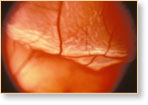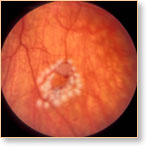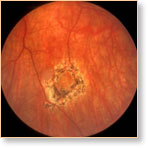Detached Retina
A person's retina works like the film in the back of a camera — it collects all the images received by the eye, instantly "develops" them and simultaneously transmits those images to the brain.
The retina is the inner layer of the eye ball, and may sometimes get split from the outer layers, and become detached.
Detached retinas are more likely to occur after middle age and affect people who are near-sighted.
How does the retina become detached?
Tiny tears or holes in the retina are usually caused by aging of tissues in the eye.
The eye largely maintains its round shape from the gel-like vitreous that fills its interior. Aging often causes the vitreous to shrink, and some of the fine fibres, linked to the retina, may be pulled free — causing a vitreous detachment. This can cause tears or holes in the retina, which allows fluid to get under the retina, leading to the detachment.
Some symptoms
While it is normal to see "floaters" in the eye, if there is a sudden increase in the floaters or development of flashes or cobwebs, this may be an indication of a retinal tear.
A much more serious condition is if the retina becomes detached. This happens when the flue gets under the retina and it starts a peeling process. As this peeling process reaches the central zone (the macula) the vision loss will be dramatic — and urgent surgery is required.
Treatment
For some new or small tears, before a detachment has started, the treatment will likely be limited to the use of a laser or cryotherapy. However, if a retinal detachment has occurred, all the holes in the retina must be sealed.
Extensive detachment requires major eye surgery, usually in the Royal Alexandra Hospital.
Among the procedures and appliances that might be used in treatment are:
- Cryotherapy: freeze-burning of the tissues to seal the tears and create a tiny scar on the retina;
- Lasers: burning of the tissues and sealing tears and holes by high energy light beams;
- Silicone surgical explants: the sewing of flexible strips to the outside surface of the eye to compress the eyeball over tears and detached areas;
- Drainage: surgically draining the fluid under the detached retina, to allow it to settle back into its regular position;
- Vitreous surgery: removing the vitreous gel, opaque debris and membranes from the inside of the eye and from the retinal surface; and
- Intraocular gas: injection of bubbles of air or special gasses into the eye to push or hold the retina in place.
Prognosis
More than 90% of detachments can be successfully treated, with the retina re-attached with one procedure or surgery. It is vital, however, that treatment takes place before the central part of the retina — the macula — becomes detached. Once the macula has been detached for a few days, there is less chance of a complete return of central vision.











